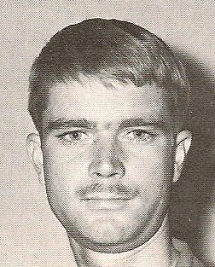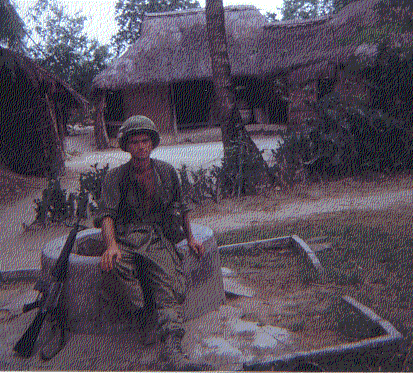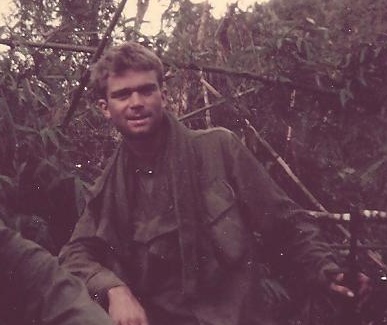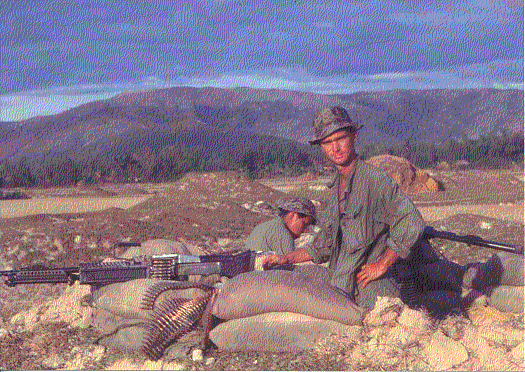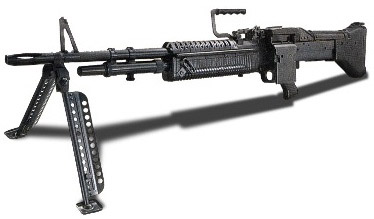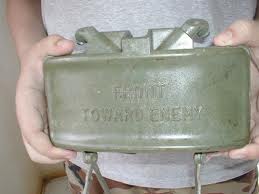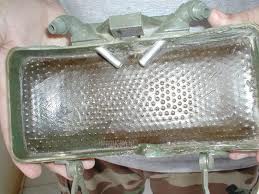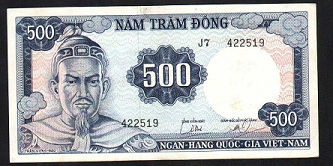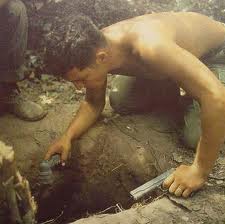My fear going into the hole was not nearly what it should have been, because the attitude of most GI's in South Vietnam who were combat soldiers (only one in ten GI's were in combat roles) was that we were dead men who weren't going to last through the 365 days we were required to stay, so we tended to take risks we ordinarily would never dream of taking, especially during the first few months in the field. Plus, if we weren't killed outright, and were just wounded, we would be sent back to the States to recuperate, and going back to the States would definitely be a good thing. Many soldiers shot themselves in the foot to avoid combat, I'm told.
I decided to take the branch to the left that doubled back and found that it dead-ended. All there was there were some bananas and a red bandanna. OK. So far, so good. Now,what about the other branch, the one on the right side? Maybe there was no Viet Cong there either. Or, maybe there was a wounded Viet Cong waiting to hack off my outstretched arms as soon as I extended them around the corner. Why did I need to find out?
I figured I had done enough, so I decided to quit while I was ahead and just back out of the tunnel feet first and out through the entrance hole. Who would know?
After a few more minutes, as I exited the tunnel, I said, "All clear, Captain. No one down there."
I returned the pistol and the flashlight, and made my way back to my place in the column, receiving what I liked to imagine were a few very respectful nods from some of the soldiers in the line, and I think one guy even patted me on the back as I passed by
Only later did I realize that I had the pistol on "safety" the whole time I was in the tunnel.
------------------------------------------------------------------------------------------------------------------------------------
GI's Carelessness Nearly Causes Friendly-Fire Deaths
Our platoon of twenty men had been ambushed a half-hour before, and I was really on edge, sure that all of us would be attacked again any moment as we walked single-file across a muddy field. To minimize my reaction time, I did what I wasn't supposed to do: I took my automatic rifle off safety and put it on full automatic. Two clicks back. One pull on the trigger would release a storm of bullets, each traveling at a speed of about 3000 feet per second, or about 2000 miles per hour.
I need to back up and explain that carrying the nine-pound rifle around all day wears on you, so many of us made slings out of spare shoelaces, as shown in the figure below, and hung the rifle from our shoulder, horizontally, with the muzzle aimed forward, weapon ready to fire. Our fingers were always inside the trigger guard, and on the trigger, not outside the guard and off the trigger the way more cautious police departments train their officers to do. But we were supposed to at least always keep the the safety switch on so it wouldn't fire if our finger accidentally pulled the trigger.
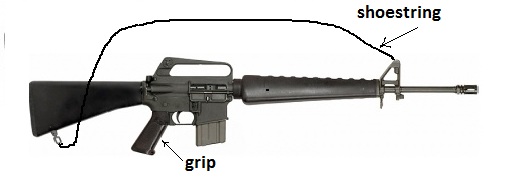
I was fourth in the line. At some point I relaxed my hold on the on the rifle's grip, expecting the sling to take up the slack and prevent the rifle from moving downward. Unfortunately, the sling without my knowledge had slipped off my shoulder, and as the rifle moved downward a few inches, the trigger fell into my trigger finger, releasing a spray of four or five bullets forward, which landed near the feet of the soldiers in front of me. They, too, had been expecting another ambush, so they, and the dozen or more men in trailing behind me, sure that we were being attacked, launched themselves with great haste downward into the mud, expecting no doubt that these were their last moments on Earth.
I was the only one still upright, and I held up my hand by way of explanation and silent apology, and fifteen white-faced men, happy still to be alive, rose to their feet and continue their march without a word of criticism. Maybe they talked about me behind my back later, but no one ever said a word to me about it afterwards. If the rifle had been pointing at a slightly different angle, two or three men might have been killed or badly wounded because of my nervous carelessness. That was the most embarrassing thing that ever had happened to me.
------------------------------------------------------------------------------------------------------------------------------------
Wilson Kee Dies and North Vietnamese Scout Begs for His Life
Wilson Kee was a Navaho or Zuni Native American (Indian), I don't remember which. He seldom spoke, but that may in large part be due to the fact that English was his second or third language, behind Navaho or Zuni, and Spanish. He was an excellent point man and all-around good soldier, but not at all friendly. I later learned from his family that he joined the Army following some problems at home, and those problems may have been on his mind and worrying him the whole time he was in South Vietnam and that would account for his generally sour disposition.
Nguyen Kao was a captured North Vietnamese Army soldier who traded imprisonment and maybe worse for the promise of better treatment if he were to become our scout, helping us avoid falling into ambushes planned by by his former confederates. One of his jobs was to warn us when he felt we were getting close to any places along the trails where his former comrades would be likely to be lurking, and to help us avoid likely locations of booby traps. For this service, he would be treated well, at least well compared to treatment he would receive in a concentration camp.
In patrolling the jungle, we always needed to very careful not to snag our feet on the fishing lines that the Viet Cong and NVA would string across the paths we traveled.
One end of the line would be connected to the safety pin ring of a grenade that is tied to a tree branch or trunk near the ground, and the other end is tied to something else at ground level on the other side of the path. When the wire, which is almost invisible in the semi-darkness of a jungle, is kicked by the advancing boot, the grenade's safety pin is pulled out.
Grenades of the type we used in Vietnam (see photo below) contained an explosive charge in a metal body, designed to break into sharp metal fragments ("shrapnel") that fly away at high speed when the grenade explodes.
|
|
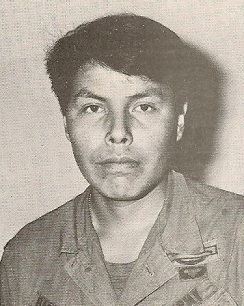
Wilson Kee, 1970
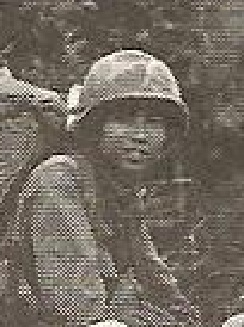
Nguyen Kao |
The shrapnel has a killing radius of 5 to 10 yards. About four seconds after the pin is pulled, the safety lever (the "spoon"), normally held in place by the hand grasping the grenade, will fly away from the grenade and activate a timing mechanism, and about four or five seconds later the grenade explodes. As long as the thrower keeps his hand wrapped around the grenade, keeping the spoon in place, the countdown will not begin. When the grenade is thrown, the spoon flies off, the thrower ducks down, and four or five seconds later the grenade explodes.
Another booby trap design has the firing pin already removed and the grenade, with the spoon still in place, is placed inside a can with a diameter a little larger than the grenade's width. The can keeps the spoon in place, but when the fishing line draped across the trail is tripped, the grenade slides out of the can, the spoon pops off, and the grenade explodes four or five seconds later.
....................
It was a wonderful day for war in South Vietnam. The weather was relatively cool, about 80 degrees, the skies were clear, and we were taking a slow walk up a shaded mountain creek bed. |
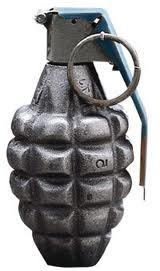 |
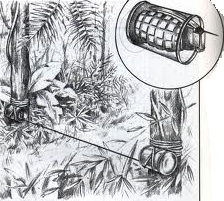 |
I remember thinking how great this was: the pace was slow, it was cool out, we had left our 60-lb back packs back at our main base in the valley, and the creek bed initially was comparatively flat--not inclined, so we didn't have work hard to pull ourselves up steep terrain with a heavy load, as was usually the case.
I was sixth in a marching column of about 20 soldiers. My best friend, Sheldon Harris, of Cedar City, Utah, was walking point. Walking point was extremely dangerous, because if Viet Cong are caught by surprise on the trail ahead--surprise for us, and surprises for them, the point man is the one who will be the enemy's most immediate target. On the other hand, if the Viet Cong know ahead of time we are coming because they see us marching along the trail toward them, they will let the first two or three men go through and wait for the main body of our forces to be in the "killing zone," then open fire with everything they have.
The usual scenario, however, was one in which a small enemy force of one or two men would see us coming, have five minutes to prepare, and place a trip-wire booby trap on the path. The point man trips the wire, doesn't notice it, doesn't hear the spoon pop off the grenade, and keeps walking.....one step.....a second step....a third.....a fourth, then the grenade explodes, killing or wounding the second guy in line, who by that time has walked forward into the grenade's killing zone.
|
|
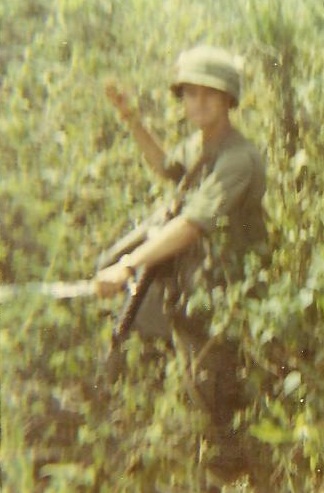
Joe Alward on Patrol |
Just as often, the popping of the spoon is heard, and then we have four seconds to bury our faces on the jungle floor and cover our heads with our helmets. It didn't happen that way this time. The first three men in the line, led by Sheldon, followed by Wilson Kee and the former (or current?) enemy, Nguyen Kao, then the Lieutenant and his radio operator, David Patterson, had climbed up and out of the creek bed to follow a trail they had found leading away from the creek.
This might lead to an enemy encampment, the captain thought. If our lieutenant had been leading the patrol, not the captain, he probably would not have wished to go look for trouble. The lieutenant wasn't a "lifer," who would make a career out of the Army, but the captain was. In retrospect, it certainly would have been better for Wilson Kee if we had just let the enemy alone that day.
Anyway, the five of them--Sheldon, Wilson, and Nguyen, the Lieutenant, and David
had climbed over the rock wall at the edge of the creek, and had advanced about five yards before I had a chance to pull myself up. At that moment, there was an explosion, followed by screams. Someone had tripped the booby trap wire. I couldn't yet see what had happened or who was screaming, but I figured Sheldon was hurt and dying, since he was walking point. When I climbed up, I found Sheldon standing, white as a ghost, his M-16 pointing up the trail. Had he already sprayed the trail up ahead? I asked. He had.
"Spray it again," I suggested, and he did. Wilson Kee was down and either dead or unconscious; the scout was lying down also, and was crying in pain. The medic, whose name I've forgotten, rushed up from the rear, and reached Wilson after about two minutes, and began trying to resuscitate him, while I began patching up the scout, who was bleeding from two or three places, nothing real serious, about two feet from where Wilson lay. A few minutes later, the medic radios back, "Willson's dead, Captain."
On hearing Wilson declared dead, the scout inexplicably begins begging me to do something in his very bad English. I was able to make out that he would give me the few possessions he had on him--his transistor radio, and his money if I would not let him die, or not kill him. He evidently thought he was dying, and that I would let him die, or maybe kill him, because I would now suspect that he was really a spy, a double turncoat, and that I thought he had no intention of warning us of danger ahead. I think he I thought I or the others might shoot him, then and there, in revenge.
I didn't shoot, and I didn't even want to.
Nguyen never scouted for us again, though; he was sent back to the rear. I encountered him again back in the rear, a few months later when I was given a job in the rear, a relatively safe place. There I became the editor of the battalion's newspaper, a mimeographed eight page paper that was published once every two weeks and distributed to each of the battalion's 600 men. It was a one-man operation; I did the interviewing, wrote the stories, and mimeographed the newspaper.
I interviewed Nguyen and learned about his life in North Vietnam, his childhood (he was about 18 years old), and how he was forced to join the North Vietnamese Army and was sent south, but when he learned that I planned to write his story and put it in the battalion paper, and maybe it might even reach the "Stars and Stripes" (a world-wide Army publication), he panicked, and said the story of his defection to the U.S. forces might someday cost him his life. So, I didn't write the story, but not because he was afraid of what might happen.
Sheldon wasn't even scratched in the grenade's explosion. Patterson and the Lieutenant received very light shrapnel wounds.
Thirty years later, in 2000, after a relative of Willson Kee did a search of the internet using "Wilson Kee" as the keywords, I received a call from New Mexico. This person had found my name on a story about this event that I had written after the war, and placed on my website, and was able to track me down. His family knew little to nothing about his life in Vietnam, and didn't know how he had died. They wondered what he felt about the war, and whether things had been going well for him, all things considered, because he had left his home in Taos to join the Army rather abruptly, they said, following some unhappiness there, and they wanted to know more about him and his feelings.
I told the caller that Wilson was not a happy man at all, didn't communicate with anyone, but that he was an excellent soldier, and had been recommended for advanced training at the NCO (noncommissioned officer school) in Chu Lai, and he went there for two weeks, and came back a sergeant. I told his family exactly how he died, and under what circumstances. They had been in the dark about this for 30 years, and it was wonderful for them, they said, to have made this connection with someone who was at Wilson's side in his last moments.
My First Exposure to Death in the Nam
I mentioned at the top of this page that I found myself straddling a dead Viet Cong on a jungle trail for a couple of minutes. This is how that happened.
We had suprised a Viet Cong and a few of his friends on the trail and peppered him with bullets. The ones who were with him escaped, leaving him to rot right there in the middle of the narrow trail. A day later, we retraced our steps along that same trail, and the body was still there.
The person shown in the photo is not one we killed. That photo just shows a generic dead Viet Cong. That's what the Viet Cong in my story looked like, though. |
|
 |
The trail was much too narrow for anyone to step around the body, so we had to step over it. I was taking my turn doing this just as our column was commanded to freeze and go silent, as there was enemy detected just ahead. For two minutes my left foot was wedged next to his right armpit, and the right foot next to his left armpit. Maggots were piled by the hundreds in and around the dozens of holes in his body, and the smell was the worst ever. That was the first time I encountered death in Vietnam.
The enemy alert turned out to be a false alarm, and we moved on.
Viet Cong Ambush Kills One of Us, Wounds Another
Our platoon--twenty of us--were finishing having our break in a circular clearing in the jungle, when we started to pack up and leave. Two Viet Cong were setting up a booby trap on the trail just yards from our position, and were in danger of being caught--and killed, of course, when a third Viet Cong who was acting as lookout, saw us approaching and opened fire with his AK-47. The first shot went through the left calf of the machine gunner, Michael DeRose. I could see the back-blast of flesh and blood jetting jetting from the entry-side of his leg, and the same from the exit side.
An instant later it was as if a swarm of angry bees traveling at the speed of sound were zipping past me. AK-47 bullets breaking the sound barrier were passing under my armpits, past my ears, and landing at my feet. The "zipping" sound made by each bullet were miniature sonic "booms" caused when anything travels faster than then speed of sound (about 750 mph).
I launched myself to the ground and fired six magazines of bullets (18 rounds per magazine) from my M-16, somewhat indiscriminately in every direction possible, hoping to scare the enemy away, wherever in the world they might be. I didn't know where they were, so I fired everywhere, just to make sure.
Seconds later the platoon medic--we call him "Doc," half-ran, half-crawled to DeRose, but before he made it half-way across the ten-yard gap between him and DeRose, he was shot. I and two others crawled to him and pulled him out of the line of fire. The firing from the enemy ended about thirty seconds after it had started. So many people's lives had changed in that short time.
Our medic was wounded. There was no one to properly treat him, so he lay there while we watched almost helplessly as his life drained away, literally. Doc was bleeding profusely, and I and others had already used all the bandages we carried in our pockets to try to stop the bleeding. I frantically grabbed at a nearby backpack looking for more bandages--it turned out to be David Patterson's backpack--and ripped it open, and tossed whatever contents that were not bandages aside. By the time the medical evacuation helicopter arrived ten minutes later, Doc's face was white as a sheet of paper.
David Patterson and I lifted Doc through the door of the helicopter, and it took off. A report came back an hour later that he was dead.
|
|
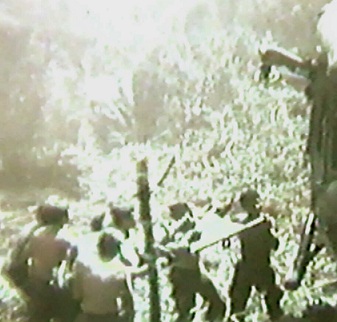 |
I was drenched in blood from my neck to my belt. I later learned that Doc had been hit in his spleen. The spleen is a blood-filled organ located under your ribcage, on the upper left side of your abdomen, and blood had rushed from the ruptured spleen, and out the bullet hole onto my arms and chest as I helped lift him onto the chopper.
This photo above does not show the actual evacuation of Doc, but it is similar to the type of evacuation that occurred with Doc. The main difference is that we didn't use a stretcher to load Doc onto the helicopter.
Right after the chopper had taken off, Patterson called my attention to the fact that I had thrown out his lunch. My mistake, I said. He didn't really care that much. After all, better to lose just your lunch than your life, he probably thought.
I also later heard that another platoon that had been on patrol nearby during our ambush, but did not receive enemy fire, received instead heavy M-16 fire from our position, and they were very angry about that, and wanted to know who in our platoon was firing at them. I never said a word.
Hunter-Killer Ambush Kills Two Viet Cong
Hunter-Killer teams are teams of six men who paint their faces green and black on nights when there is no moon, and walk forth late at night into villages that are supposed to be abandoned, hunting for Viet Cong who take up nighttime residence there, then kill them dead. Sneaking around South Vietnam in the pitch darkness, looking for someone to kill, while trying to avoid being one seen first, and killed, is the scariest thing I did.
This time, the entire platoon of twenty of us went on a hunter-killer patrol. We set up in the bushes about forty yards from a few grass huts where we suspected would soon be visited by Viet Cong, and waited. Most of us were asleep, though a few guards stood watch. At three in the morning, the guard on watch nudged me awake, and told me the sergeant said to get ready to fire at his command into the area where the huts were located.
We all did our job, and twenty seconds later, two Viet Cong lay dead.
I hadn't fired my weapon in days, and my eardrums had had time to recover, so when I fired my M-16 that early morning, the noise came as such a shock to me in my half-awake state, that I stopped firing before I had even completely emptied one magazine (18 rounds). My ears were more important to me at that moment then the killing of the VC that was going on.
After the counting of the bodies, and returning to our ambush positions, we went back to sleep, most of us. We didn't expect any more customers after that.
The Viet Cong in the Bush
One day about noon our platoon was gathered around the perimeter of a 20-yard diameter clearing surrounded by a circular berm covered with six-foot tall bushes. About a hundreds yards away was another platoon. I saw the bushes move about ten yards from me. On the other side was a trail along which somebody was traveling, and they were getting closer and closer to me. When the rustling of the bushes reached point directly across from me on the other side of the bushes, not more than ten feet away, I cut loose with three bursts of six rounds each, bush branches exploding and leaves disintegrating against the bullets' fury.
A moment later, a sergeant near me, who caught a brief glance at my target, exclaimed, "VC! VC!" He had seen a Viet Cong, probably filled with holes, I thought.
Before confirming my kill, I half-crawled, half-ran ten yards to the command post in the center of the clearing to give my situation report to the Lieutenant. I could barely contain my excitement, but my joy soon turned to mortification when I heard the sergeant radio the command center to say that the Viet Cong actually had ducked under my cascade of eighteen bullets and scampered away with a smile on his face. I had assumed he was walking, brushing up against the branches bordering the narrow trail, and had fired at chest level, but he was crawling to avoid being seen by the other platoon a hundred yards away. He was aware of their presence, but somehow was unaware of our presence just on the other side of the bushes. He was the luckiest Viet Cong in South Vietnam that day, I am sure, and I was perhaps the unluckiest GI.
Playing Chicken
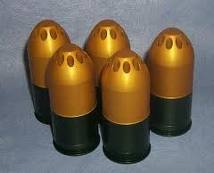
M-79 grenades are about 1.5 inches wide, and two inches tall.
Its killing radius is about 5 meters
|
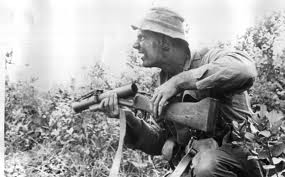
The person holding the M-79 in the photo
above is not me. |
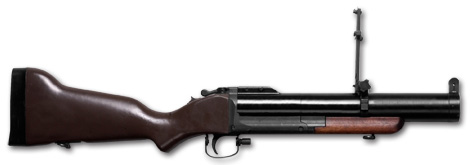
M-79 Grenade Launcher
Who would chicken out first?
I had guard duty on a hill overlooking a village. We had sandbag bunkers all around, maybe ten of them. It was about 2:00 am, and I decided it was time for some routine HI fire. HI is "harassment and interdictment," which means annoy your enemy, and prevent his sneaking up on you by periodically and randomly firing at places outside the perimeter. If we do this often enough, they cannot be sure they won't be unlucky when they attempt to launch a sneak attack and get caught in our HI fire.
So, I fired one grenade from my M-79 grenade launcher at a place about thirty yards directly forward of my bunker. The bunker next to mine decided to do the same thing. Then, I fire another grenade a little off to my right, a little closer to his bunker, then he does the same. After three or four more back-and-forths like that, his grenades are landing about ten yards from my bunker, so I launch one that lands about five yards from his bunker, and he gives up. "CUT IT OUT!!" he shouts. I guess he realized that his bunker was inside the grenade's killing radius, and maybe the next one from the crazy GI in the bunker on his left side might put the next one inside his bunker.
Tormenting Captured Viet Cong
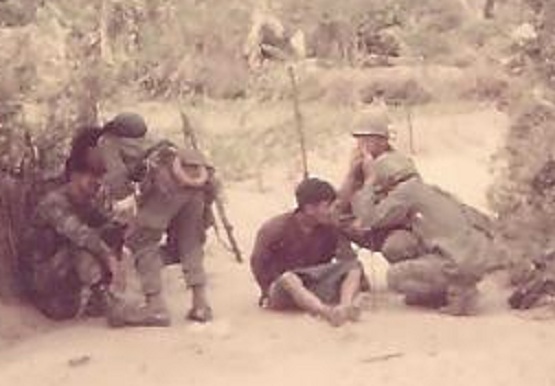
This photo shows Captain David Franson and three South Vietnamese soldiers
interrogating a captured Viet Cong. They're telling the VC that the gunshots he
just heard signaled the killing of his partner (it wasn't true), and the same would
happen to him soon if he didn't reveal the location of buried cache of weapons we
were sure were nearby. To encourage him to talk, in case he didn't believe his
friend was really killed, his pants were pulled down to his knees and a bamboo
stick (not visible) was being used to flick his private parts.
It didn't work.
The Viet Cong refused to talk. I think he knew that the rules regarding
treatment of captives in the Americal Division had changed in the last few months,
since the story about the massacre at My Lai come out, and severe political
pressure was being felt by the politicians back home, and by the military leaders in
Vietnam. So, we didn't kill prisoners anymore in cold blood. Maybe just a little whipping with a bamboo stick against the groin area, that's all.
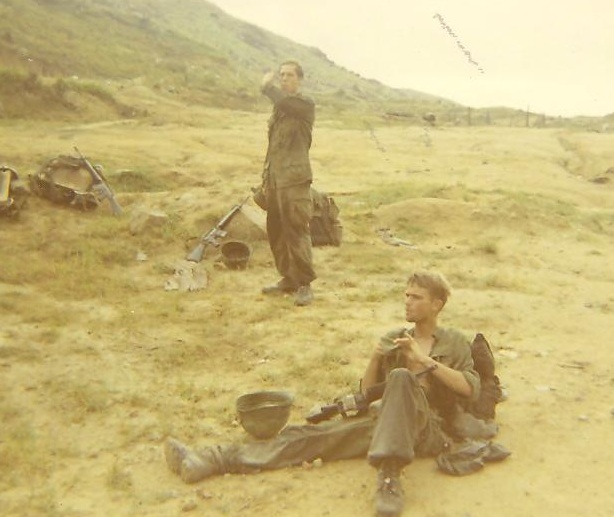
Joe Alward sitting with rifle in lap. Lonnie Liscomb, who would soon become our
platoon sniper, is standing.
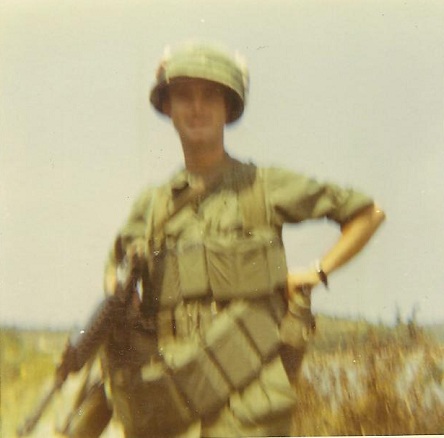
Here I am, about to go on patrol, absent the usual 70-lb back pack.
I am traveling comparatively lightly, but still with more than enough
"magazines" (a "magazine" is a metal ammunition storage and
feeding device) to fight a small war. I was always paranoid about
running out of ammunition, so I wore two "bandoliers" of
magazines, rather than the normal one bandolier. Some of the
pouches of my bandolier are stuffed with two magazines, which is
also not normal. A plastic canteen is under my left hand,
mosquito repellant and bandages are
under my elastic helmet band.
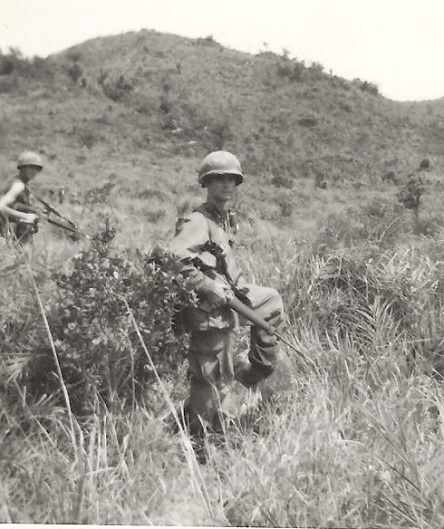
Joe Alward on patrol. Jack Reilly is at the left. Jack's back and
neck would be peppered with dozens of tank mine shrapnel when
Ed White tripped the booby trap described in a story above. Reilly's
photo is below.
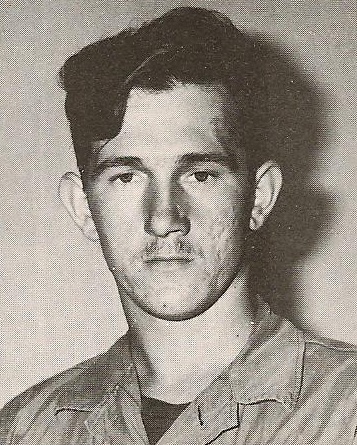
John "Jack" Reilly
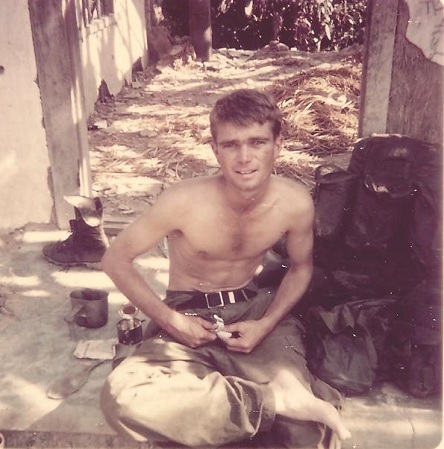
Photo above of Joe Alward treating a foot blister in an abandoned village. Canteen cup,
package of cocoa mix, and a can of C-Rations is behind me. My
backpack is on the right in the photo.
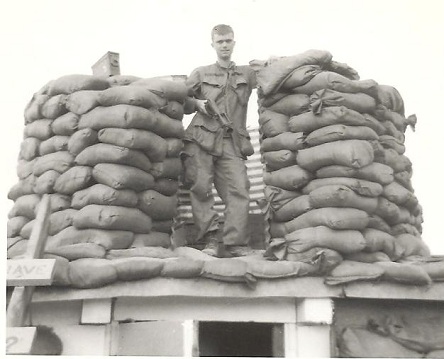
Joe Alward on guard duty atop our bunker on Hill Debbie. An
M-79 grenade launcher is in my right hand. This is not the bunker
of infamy I describe in the "Playing Chicken with Grenades "
story I told earlier.
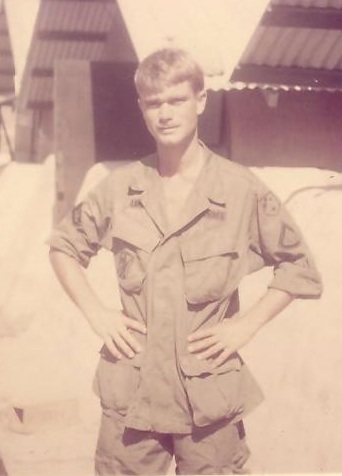
Joe Alward. Then photo above was taken during
"stand down," a ten-day rest period during which we
cleaned our weapons, got medical attention, and
generally relaxed and had a good time away from the
fighting. Under my lapels are the "US Army" tag, and
my name, "Alward." On my left and right shoulders are
the PFC patches ("Private, First Class"). Also on my
left shoulder is the Americal Division patch, the
"Southern Cross."
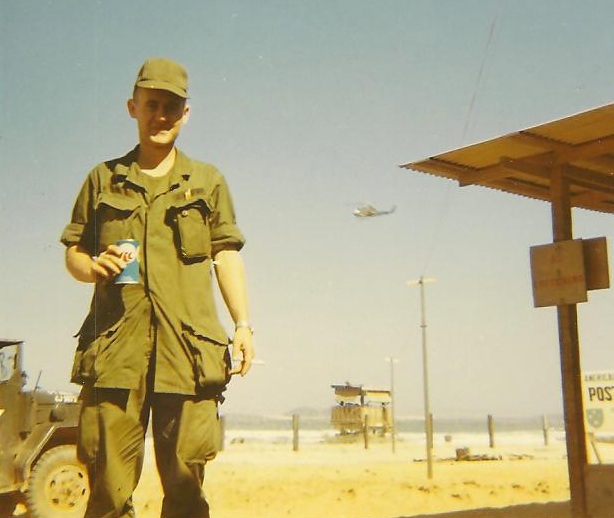
Sheldon Harris in January, 1970. Chu Lai, Quang Ngai Province, Republic of South
Vietnam. This photo was taken a few days after we had arrived in Vietnam, and a few
days before we would be flown south, where we would join our company. In the background
is a guard tower about 100 yards from the South China Sea. Sheldon was the point man in
the story I told earlier about Wilson Kee and our scout, the former NVA soldier, Nguyen Kao.
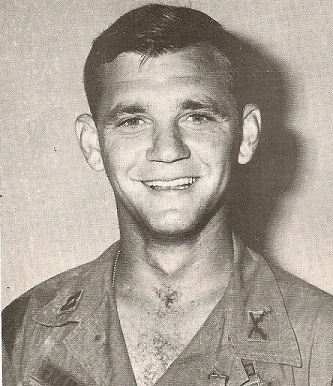
Captain David C. Franson
Captain Franson, was climbing behind me up a steep, bolder-strewn trail. I was very top heavy, owing to the 70-lb backpack I was carrying, and he caught me as I started to fall backward. In less stressful times in the secure rear area after I was pulled out of the jungle to become the editor of the battalion newspaper, we were bridge partners on one or two occasions. After he had bid six no-trump, with my encouraging bidding, and went down four tricks, the medics against whom we played in their hootch one night ribbed him mercilessly, and we never played together again. |
|
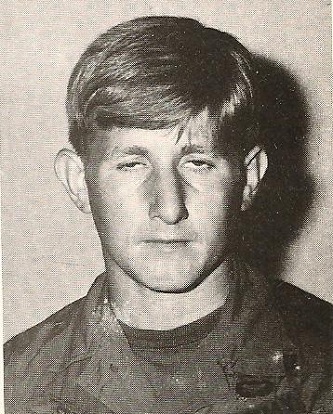
Staff Sergeant Harry R. Steed
Steed was the designer of the "Mickey Mouse" ambush described in an earlier story. In other action, Steed won the "Silver Star" for bravery. Basically, he shot to pieces a lone, half-naked Viet Cong who was sneaking under the barbed wire with an explosive device, before he got closer than thirty yards from Steed. |
| |
|
|
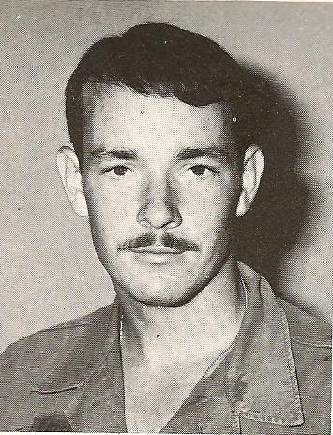
Sergeant Keith Harwell
Keith was our squad leader. A squad is half a platoon--ten men. My earliest memory of Keith is when we torn the wax coating from inside the cardboard tubes used to contain mortar shells, and burned it to provide light while we played cards, in January, 1970, just after I arrived in South Vietnam. We were on LZ Charlie Brown at the time. LZ stands for "landing zone." LZ Charlie Brown was ten miles southeast of Duc Pho. Almost completely surrounded by water, near the American built port, Sa Huynh. |
|
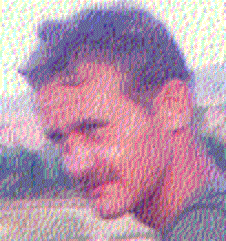
Sheldon Harris |
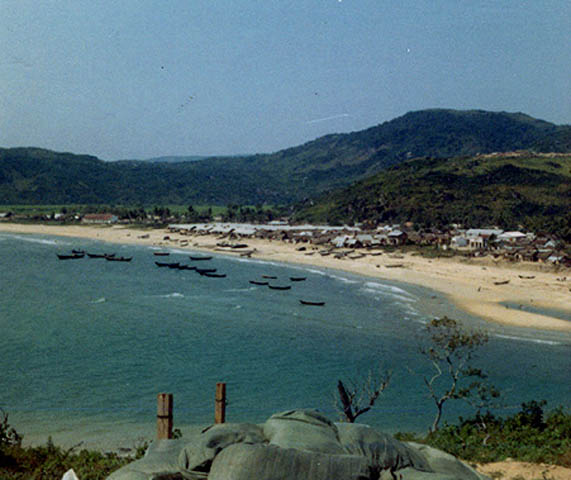
Sa Huynh. Photo is taken from the top of LZ Charlie Brown.
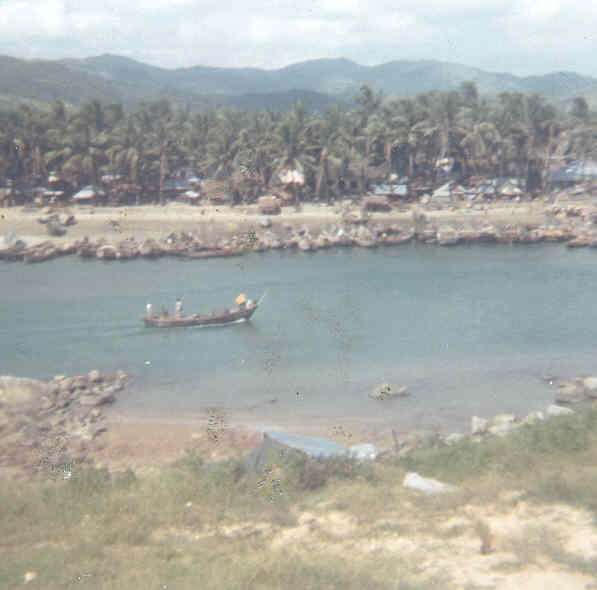
Another view of Sa Huynh from LZ Charlie Brown. A Viet Cong floated across this body
of water late one night, planning to blow up a bunker on Charlie Brown, but Staff Sergeant
Harry Steed was waiting; he greased him with his M-16, and won the Silver Star for bravery.
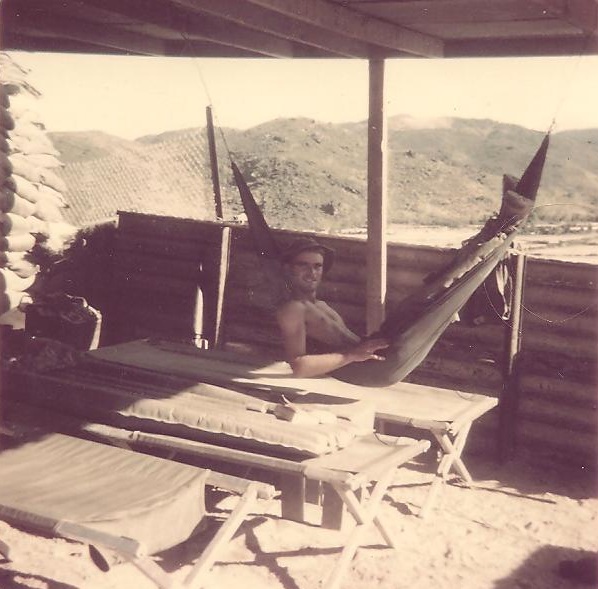
Joe Alward in hammock inside bunker on LZ Debbie, near Duc Pho, South Vietnam.
This photo was taken during one of our company's "stand down" periods. They lasted
10 days. We didn't go on patrol during this period, which was intended for resting and
recuperation. All we were required to do was guard the hill, and let other companies do the
patrolling below.
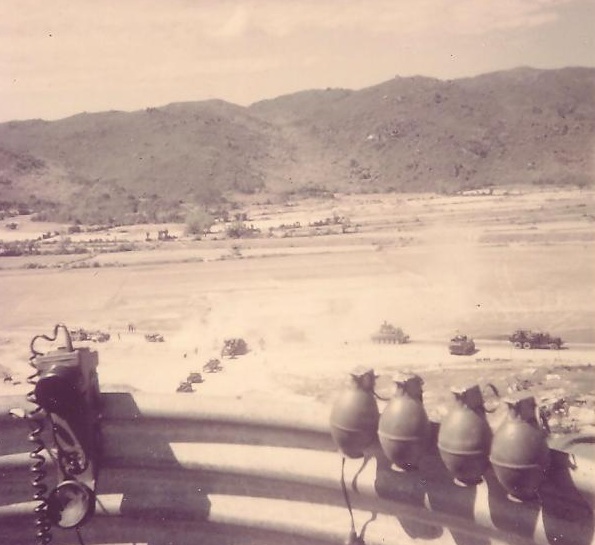
This is a view from the top of LZ Debbie, overlooking the flatlands below. A convoy of
tanks trucks and jeeps is on its way to resupply companies to the north. A phone is on
the left in the photo; it was connected by telephone wire to the command post. NOte the
new style of grenades; they were not corrugated like the older-style grenades (see the
at the top of this page). Their smoother surface allowed one to throw them farther,
because of reduced air resistance. There were not enough M-79 grenade launchers, so
not every fighting position had one, so sometimes we had to launch our grenades the old-fashioned way--by throwing them. That reminds me of the time during stand-down that we
had a grenade-throwing contest. I will tell that story, below.

Crossing another creek in South Vietnam, looking for Viet Cong and hoping we
wouldn't find any.
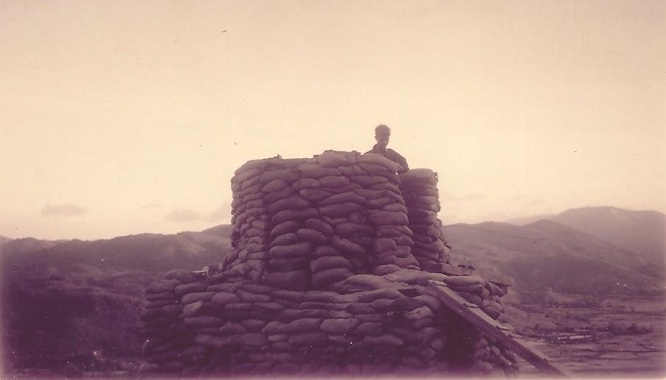
Joe Alward atop sandbag bunker on a hill overlooking the "Rice Bowl" valley.
When darkness comes, I and other guards in other bunkers would engage in "H & I" fire. That's "harassment and interdictment," which means that we would preemptively pop flares, throw or fire grenades, or fire our rifles or machine guns down the hillside to interrupt possible enemy incursions. If we didn't do this randomly, every half-hour or so, they might be able to sneak up on us. They would first have to wind their way past all of the trip wires connected to the flares we place on the hillside, though.
One evening a cook was on guard on in a bunker on the perimeter, and an Australian combat veteran on his third tour of duty in South Vietnam, who was visiting our American-held bases, was drunk on whisky in a nearby bunker. He was bragging to his also-drunk friends that he was as good or better than the Viet Cong "sappers" who were experts at infiltrating enemy lines by crawling under the barbed-wire, and that American GIs were too incompetent to guard perimeters.. So, to prove it, he stripped to his shorts, muddied himself, and crawled outside the perimeter, then crawled back. He was going to crawl through the wires, avoid all the trip wires, and make it all the way through, he said.
He got half-way to the cook's bunker before a randomly-popped flare caught illuminated him, and before he could shout out not to shoot, the Aussie was cut to pieces by the cook's machine gun. |
|
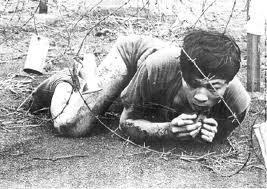
Viet Cong Sapper demonstrating how to navigate barbed wire. The can hanging from the wire had several pebbles inside. When the wire is jiggled even just a little bit, the pebbles are rattled around in the can, the sound signaling movement on the wire. All hell would break loose at that point, if GIs weren't asleep while on guard duty. |
|

